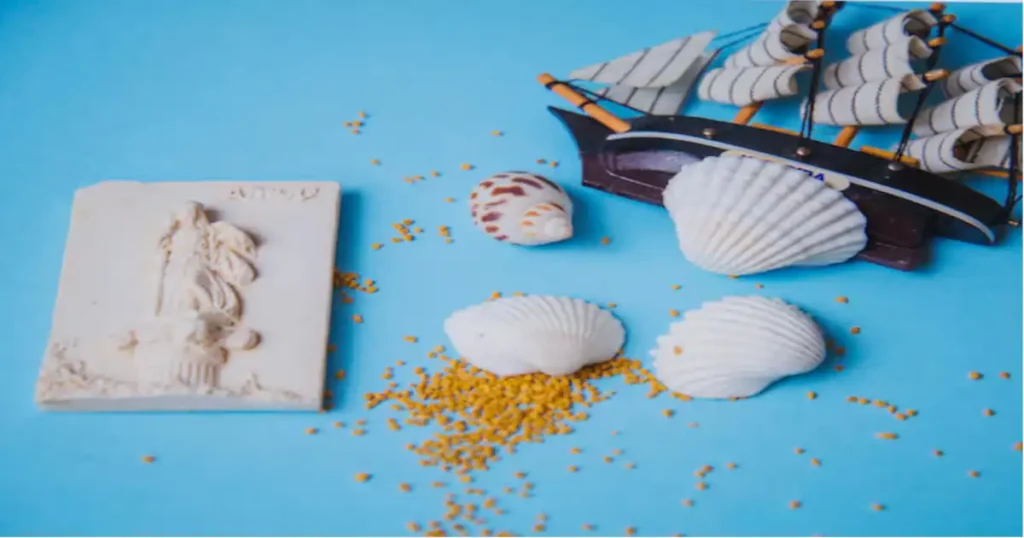Exploring the Fascinating World of Cowrie Shells
Cowrie shells are not just beautiful objects; they carry deep cultural, historical, and ecological significance. These glossy, often brightly colored shells have captivated people for centuries and continue to be a subject of interest in various fields, including anthropology, archaeology, and marine biology. This article delves into the intricate world of cowrie shells, exploring their types, uses, cultural significance, and environmental importance.
What Are Cowrie Shells?
Cowrie shells belong to the family Cypraeidae, which includes around 200 species of marine snails found primarily in tropical and subtropical waters. Characterized by their smooth, shiny surfaces and often vibrant colors, cowrie shells are typically oval or rounded in shape, making them easily recognizable. The unique structure of these shells is a result of the mollusk’s growth process, during which it secretes layers of calcium carbonate.
The most notable features of cowrie shells include:
- Glossy Finish: The outer layer is smooth and reflective, often resembling polished porcelain.
- Color Variability: Cowrie shells come in a variety of colors, from creamy whites to deep browns and striking yellows and blues, often with intricate patterns.
- Distinctive Aperture: The opening (aperture) of the shell is long and narrow, with a unique arrangement of ridges or teeth, adding to their identification.
Types of Cowrie Shells
Cowrie shells can be classified into several categories based on their size, shape, and habitat. Here are some of the most well-known types:
1. Cypraea moneta (Money Cowrie)
The Money Cowrie is perhaps the most famous of all cowrie shells, historically used as currency in many parts of the world, particularly in Africa and Asia. Their smooth surface and striking appearance made them highly valued, leading to their use in trade.
2. Cypraea tigris (Tiger Cowrie)
Named for its striking resemblance to a tiger’s stripes, the Tiger Cowrie features bold patterns of orange and brown. This species is often sought after by collectors for its beauty and rarity.
3. Cypraea argus (Spotted Cowrie)
The Spotted Cowrie is characterized by its spotted patterns that can vary significantly among individuals. These shells are often found in the Indian and Pacific Oceans and are prized for their aesthetic appeal.
4. Cypraea ovula (Ovula Cowrie)
Ovula Cowries are recognized by their oval shape and delicate patterns. They are often found in shallow waters and are popular in jewelry-making due to their elegant appearance.
5. Cypraea pantherina (Panther Cowrie)
This cowrie species is known for its dramatic color patterns, resembling the spots of a panther. Its unique look makes it a favorite among shell collectors.
The Historical Significance of Cowrie Shells
Cowrie shells have played a vital role in human history, particularly in trade and cultural practices. Their use as currency dates back thousands of years, providing insight into early economic systems.
Cowries as Currency
In many ancient cultures, cowrie shells were used as a form of currency due to their durability, portability, and universal appeal. The Money Cowrie, in particular, was widely used in Africa, Asia, and the Pacific Islands. In some regions, cowrie shells were so valuable that they became a standard measure of wealth.
- Trade Routes: Cowries were integral to trade routes, facilitating exchanges across vast distances. The shells made their way to Europe and the Americas, often changing hands and gaining value along the way.
- Cultural Significance: In certain cultures, cowrie shells symbolized wealth and prosperity. They were often incorporated into ceremonial attire, jewelry, and even as offerings in religious practices.
Cowries in Art and Symbolism
Beyond their monetary value, cowrie shells have held significant cultural symbolism throughout history. They are often associated with fertility, femininity, and protection in various societies. The shells have been used in traditional art forms, such as jewelry, ornaments, and decorative items.
- Spiritual Practices: In some cultures, cowries are believed to possess protective properties and are used in rituals to ward off evil spirits.
- Artistic Representations: Cowrie shells have been depicted in various forms of art, representing abundance and beauty. Their glossy finish and intricate patterns make them ideal for artistic expressions.
Cowrie Shells in Modern Times
Today, cowrie shells continue to fascinate people across the globe. Their aesthetic appeal has led to their incorporation into various modern applications.
1. Jewelry Making
Cowrie shells are frequently used in jewelry designs, including necklaces, bracelets, and earrings. Their unique shapes and vibrant colors add a natural element to contemporary fashion. The popularity of bohemian and beach-themed styles has further propelled the demand for cowrie shell accessories.
2. Home Decor
Cowrie shells are often used in home decor, lending a coastal or natural feel to interior spaces. They can be found in decorative bowls, wall art, and even lighting fixtures, bringing a touch of the ocean indoors.
3. Fashion Trends
Cowrie shells have become a trendy motif in various fashion items, from clothing to handbags. Their connection to nature and the sea makes them appealing to environmentally conscious consumers seeking sustainable fashion choices.
4. Crafts and DIY Projects
Craft enthusiasts often use Cypraeidae in DIY projects, creating unique pieces that reflect personal style. From home decor to handmade gifts, the versatility of Cypraeidae allows for endless creative possibilities.
The Environmental Impact of Cowrie Shells
While Cypraeidae hold aesthetic and cultural value, their collection and trade can have significant environmental implications. Overharvesting and habitat destruction pose threats to cowrie populations and marine ecosystems.
Conservation Efforts
To mitigate the environmental impact, various conservation efforts have been initiated, focusing on sustainable harvesting practices and habitat protection. Organizations and researchers are working to educate communities about the importance of Cypraeidae in marine ecosystems.
Ecological Role of Cowrie Shells
Cowrie shells serve an essential role in marine ecosystems. The mollusks that produce these shells are part of the food web, providing sustenance for various predators. Furthermore, Cypraeidae contribute to biodiversity, supporting diverse marine life.
Sustainable Practices
To promote sustainable practices, it is crucial for collectors and consumers to prioritize ethically sourced Cypraeidae. Supporting organizations that advocate for responsible harvesting and conservation can help protect these beautiful treasures for future generations.
How to Identify Cowrie Shells
Identifying Cypraeidae requires an understanding of their distinct characteristics. Here are some key features to look for when identifying cowrie shells:
1. Shape and Size
Cowrie shells generally have a characteristic oval or rounded shape, with sizes ranging from a few centimeters to larger specimens. Pay attention to the specific shape of the shell, as different species may have unique forms.
2. Color and Pattern
The color and pattern of a Cypraeidae can vary widely. Take note of the hue, whether it’s solid, spotted, or striped. Patterns can be a helpful indicator for identification.
3. Aperture Characteristics
The aperture (opening) of the shell is a crucial identifying feature. Observe the length, width, and any distinct ridges or teeth along the edges.
4. Surface Texture
Cowrie shells typically have a smooth, glossy surface. Inspect the shell for any irregularities or textures that may differentiate one species from another.
Collecting Cowrie Shells Responsibly
For enthusiasts interested in collecting Cypraeidae, it is essential to do so responsibly to ensure the preservation of these beautiful marine treasures. Here are some guidelines for ethical collecting:
1. Research Local Regulations
Before collecting Cypraeidae, research local regulations regarding shell collection. Many regions have specific laws in place to protect marine life and habitats.
2. Collect Sustainably
Limit the number of shells collected, and avoid taking live specimens. Sustainable collecting ensures that populations remain healthy and ecosystems thrive.
3. Support Conservation Efforts
Consider supporting organizations focused on marine conservation. By contributing to these efforts, collectors can play a part in protecting the habitats where Cypraeidae thrive.
4. Educate Others
Share knowledge about the importance of Cypraeidae and responsible collecting practices with fellow enthusiasts. Education is key to fostering a culture of conservation.
Conclusion
Cowrie shells are more than just decorative objects; they embody a rich tapestry of history, culture, and ecological significance. From their historical role as currency to their contemporary uses in fashion and decor, Cypraeidae continue to captivate and inspire. However, as we appreciate these natural treasures, it is crucial to recognize the importance of sustainable practices and conservation efforts. By respecting the environment and the delicate ecosystems that produce Cypraeidae, we can ensure that future generations will continue to marvel at their beauty. Whether as a collector, artist, or simply an admirer, embracing the world of Cypraeidae is a journey worth taking.
Frequently Asked Questions (FAQs)
What are cowrie shells, and where do they come from?
Cowrie shells are the hard outer coverings of marine snails belonging to the family Cypraeidae. Found predominantly in tropical and subtropical waters, these shells are known for their distinctive glossy appearance and vibrant colors. The snails produce these shells as a protective layer, which they inhabit throughout their life.
How have cowrie shells been used throughout history?
Historically, Cypraeidae have served various purposes, most notably as a form of currency in many cultures around the world. Their durability and portability made them ideal for trade. Additionally, these shells have been used in art, jewelry, and ceremonial practices, often symbolizing wealth and fertility.
Are cowrie shells environmentally friendly?
Cowrie shells can be environmentally friendly, especially when sourced sustainably. Overharvesting and habitat destruction can threaten marine ecosystems. It is essential to collect these shells responsibly, following local regulations, to ensure the protection of the species and their habitats.
How can I identify different types of cowrie shells?
Identifying cowrie shells involves examining several key characteristics. Look for the shell’s shape, color, and surface texture. Pay close attention to the aperture (the opening of the shell) and any unique patterns or markings that can help differentiate species.
Can I use cowrie shells in crafts and home decor?
Yes, cowrie shells are popular in crafts and home decor due to their aesthetic appeal. They can be incorporated into jewelry, decorative items, and even art pieces. When using these shells, consider sourcing them ethically to support conservation efforts.
What should I consider before collecting cowrie shells?
Before collecting Cypraeidae, research local laws and regulations regarding shell collection. It’s crucial to practice sustainable collecting methods, such as avoiding live specimens and limiting the number of shells taken. Supporting conservation initiatives can also help protect marine environments for future generations.
READ ALSO: BizCover: Revolutionizing Business Insurance for Small and Medium Enterprises







